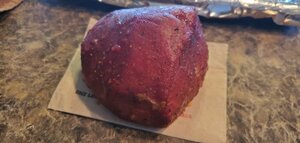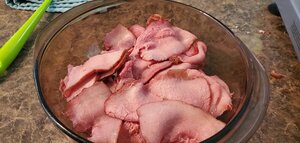Great Primer!
The Basics of Salting
The Science of Salting
In salami, salt absorption simply happens when you mix all the salt and seasonings into the ground meat and fat. The surface area of the ground meat is high enough that the salt will quickly and easily be absorbed. No special conditions or even further mentions are needed for successfully salting salami.
In whole muscles, salt absorption and distribution may require several weeks, but the process is simple, reliable, and hands-off. Salt absorption and dispersal will take a couple of days for a thin slice of loin, a couple of weeks for a coppa, but might take 2 months for a large bone-in ham.
The key to salting meat is the process of diffusion. If you remember your high school biology, the concept behind diffusion is the tendency for substances to disperse through a substance until an even concentration, or equilibrium, is reached. For example, if you dissolve salt into a glass of water, you won’t find pockets of saltier water in the glass—the concentration of salt is equal throughout. The same concept can be applied to meat—given enough moisture in the meat for the salt to dissolve, the salt will disperse to create an even concentration throughout the meat. (As a side note to those who remember diffusion and osmosis always being taught together, osmosis is also involved in this process, but osmosis is a type of diffusion, and specifically involves movement across a semi-permeable membrane.)
The process looks like this:
First, salt is applied to the outside of the meat and begins dissolving into the layer of moisture coating the meat. The dissolved salt starts to migrate from the area of high concentration (the salty outside of the meat) to the area of low concentration (the interior).
At the same time, the water inside the meat (a high concentration of water) starts migrating to the salty layer on the outside (a low concentration of water). This results in moisture leaving the meat. Not enough moisture is lost for any significant drying of the meat.
What then follows is a back-and-forth of salt and water. Salt goes in, water goes out, but as the salt concentration increases inside the meat, the water “follows” the salt back in, and everything keeps moving around, slowly reaching equilibrium.
If you’re salting a piece of meat in a plastic bag, and one day you notice lots of liquid in the bag, then return a few days later to find it relatively dry, it’s because the water was reabsorbed by the meat as the interior became more salty.
If you’re salting the meat on a rack, as opposed to in a bag, the exuded liquid cannot be reabsorbed, so you have less moisture remaining in the meat at the end of the process, and the drying process may be a little quicker. You’ll see this in the recipe for dry-cured hams.
As the salt is being absorbed, it’s important to keep the meat cold to limit bacterial growth. Keep the salted meat under 40 degrees F, and if it’s in a sealed bag, you don’t need to worry about humidity, but if it’s open in the low-humidity environment of your fridge, it may start to dry out, which will limit the ability for the salt to move freely—I suggest covering the container that holds the meat with plastic wrap.
It’s impossible for me to tell you exactly how long this process will take, but if you use a precise weight of salt, there is no threat of oversalting, so I’ll usually leave meat for 3 weeks (ham is the exception, and it’s detailed in its own section).
Note
Cure #1 contains standard table salt (NaCl) and sodium nitrite (NaNO2 ), while Cure #2 is salt (NaCl), sodium nitrite (NaNO2 ), and sodium nitrate (NaNO3 ).
Salting and Preservation
To explain why salt is important for the preservation of meat, first understand that bacteria require water to survive and reproduce; stopping bacteria by removing their access to water is the primary preservation technique of dry-curing. Along with a series of other effects, salting meat will reduce the water available to bacteria, but salt does not actually dry the meat.
To clarify, as the salt dissolves and diffuses through the meat, the salt molecules bind with the water molecules, which makes the water unavailable to bacteria, but without actually removing the water from the meat. A raw, unsalted piece of meat is a damp and ideal environment for bacteria, while a raw, salty piece of meat is still a damp place, but has significantly less water available for bacteria, allowing for short-term preservation as the meat is then dried.
The amount of available water in a piece of meat is more accurately described as “water activity,” abbreviated as Aw. Commercial producers closely monitor Aw using digital water activity meters, but observing the weight loss of a drying piece of meat is adequate for the home producer.
It’s important to note that the amount of salt used in dry-curing lowers the water activity enough to provide short-term preservation of the meat, and provides a window of time to dry the meat, but it is not enough salt for long-term preservation. In order to lower Aw enough for long-term preservation, you need to either remove water by drying the meat, or reduce the water activity by heavily salting the meat, like a piece of salt cod or salt-packed anchovies. By employing the drying process in conjunction with salt, you can achieve the long-term preservation of meat without salting beyond palatability.
The Basics of Salting






